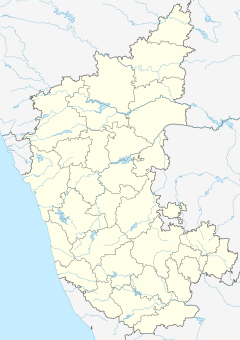Gol Gumbaz
| ಗೋಲ ಗುಮ್ಮಟ | |
 Golghumat | |
 Location of Gol Gumbaz | |
| Coordinates | 16°49′48.11″N 75°44′9.95″E / 16.8300306°N 75.7360972°E / 16.8300306; 75.7360972Coordinates: 16°49′48.11″N 75°44′9.95″E / 16.8300306°N 75.7360972°E / 16.8300306; 75.7360972 |
|---|---|
| Location | Bijapur, Karnataka, India |
| Designer | Yaqut of Dabul |
| Type | Mausoleum |
| Material | Dark grey basalt |
| Height | 51 m (167 ft 4 in) |
| Beginning date | c1626 |
| Completion date | 1656 |
| Dedicated to | Mohammed Adil Shah |
Variant Names Gol Gumbad | |
Gol Gumbaz is the mausoleum of king Mohammed Adil Shah, Sultan of Bijapur. Construction of the tomb, located in Vijayapura (formerly Bijapur), Karnataka, India, was started in 1626 and completed in 1656. The name is based on Gola gummata derived from Gol Gombadh meaning "circular dome".[1] It follows the style of Deccan architecture.[2]
Contents
1 Architecture
2 Gallery
3 References
4 External links
Architecture

Plan of Golghumat
The structure is composed of a cube, 47.5 m (156 ft) on each side, capped by a roof 44 m (144 ft) in external diameter. Eight intersecting arches created by two rotated squares that create interlocking pendentives support the dome. At each of the four corners of the cube, is a dome-capped octagonal tower seven stories high with a staircase inside.[2] The upper floor of each tower opens on to a round gallery which surrounds the dome. Inside the mausoleum hall, is a square podium with steps on each side. In the middle of the podium, a cenotaph slab on the ground marks the actual grave below, "the only instance of this practice" in the architecture of the Deccan sultanates. In the middle of the north side, "a large semi-octagonal bay" protrudes out.[2] With an area of 1,700 m2 (18,000 sq ft),[3] the mausoleum has one of the biggest single chamber spaces in the world. Running around the inside of the dome is the whispering gallery where even the softest sound can be heard on the other side of the mausoleum due to the acoustics of the space.[3]
Gallery
Dome with intersecting arches from the inside
Whispering gallery
Carvings on the wall

Gol Gumbaz c. 1860

Gol Gumbaz view from the entrance.

One of the minars as viewed from the terrace.


Historical Cannon displayed in front of Gol Gumbaz

References
^ "Gumbad (Gumbad) meaning in English". Hinkoj.com. Hinkoj.com. Retrieved 3 August 2014..mw-parser-output cite.citationfont-style:inherit.mw-parser-output .citation qquotes:"""""""'""'".mw-parser-output .citation .cs1-lock-free abackground:url("//upload.wikimedia.org/wikipedia/commons/thumb/6/65/Lock-green.svg/9px-Lock-green.svg.png")no-repeat;background-position:right .1em center.mw-parser-output .citation .cs1-lock-limited a,.mw-parser-output .citation .cs1-lock-registration abackground:url("//upload.wikimedia.org/wikipedia/commons/thumb/d/d6/Lock-gray-alt-2.svg/9px-Lock-gray-alt-2.svg.png")no-repeat;background-position:right .1em center.mw-parser-output .citation .cs1-lock-subscription abackground:url("//upload.wikimedia.org/wikipedia/commons/thumb/a/aa/Lock-red-alt-2.svg/9px-Lock-red-alt-2.svg.png")no-repeat;background-position:right .1em center.mw-parser-output .cs1-subscription,.mw-parser-output .cs1-registrationcolor:#555.mw-parser-output .cs1-subscription span,.mw-parser-output .cs1-registration spanborder-bottom:1px dotted;cursor:help.mw-parser-output .cs1-ws-icon abackground:url("//upload.wikimedia.org/wikipedia/commons/thumb/4/4c/Wikisource-logo.svg/12px-Wikisource-logo.svg.png")no-repeat;background-position:right .1em center.mw-parser-output code.cs1-codecolor:inherit;background:inherit;border:inherit;padding:inherit.mw-parser-output .cs1-hidden-errordisplay:none;font-size:100%.mw-parser-output .cs1-visible-errorfont-size:100%.mw-parser-output .cs1-maintdisplay:none;color:#33aa33;margin-left:0.3em.mw-parser-output .cs1-subscription,.mw-parser-output .cs1-registration,.mw-parser-output .cs1-formatfont-size:95%.mw-parser-output .cs1-kern-left,.mw-parser-output .cs1-kern-wl-leftpadding-left:0.2em.mw-parser-output .cs1-kern-right,.mw-parser-output .cs1-kern-wl-rightpadding-right:0.2em
^ abc Michell, George; Zebrowski, Mark (1999). Architecture and Art of the Deccan Sultanates. The New Cambridge History of India. I.8. Cambridge, UK: Cambridge University in bijapur Press. pp. 92–4. ISBN 0-521-56321-6. Retrieved 14 September 2011.
^ ab Archaeological Survey of India (2011). "Gol Gumbaz, Bijapur". Archaeological Survey of India. Archaeological Survey of India. Retrieved 14 September 2011.
External links
| Wikimedia Commons has media related to Gol Gumbaz. |
Gol Gumbad on Archaeological Survey of India website
ArchNet digital library- The Institute of Oriental Culture, University of Tokyo, Tokyo
- Listen to unique sound recordings in Gol Gumbad: acoustics described
- Magnificent Architectural Features of Gol Gumbaz in Bijapur









